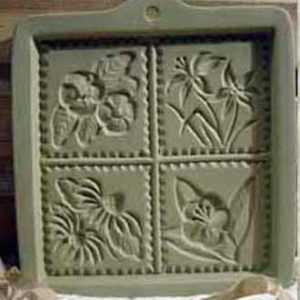Birth of a Cookie Mold
 All cookie molds start with a drawing.
All cookie molds start with a drawing.
Next, the design of a baked cookie is modeled in clay.
Plaster molds are made of the design, and refinements are made until the positive cookie image looks just right.
A plaster “cookie mold” is carved out of the block of plaster, then “casting molds” are made.
At this point, a cookie mold is ready for production.
The actual ceramic mold that you use can be made one of two ways. It can be pressed on a big hydraulic machine called a “ram press”. The mold is then cleaned and finished by hand, then fired to a very high temperature to produce the durable product.
Or a cookie mold can be “hand cast”. This means that liquid clay, or “slip”, is poured into each plaster casting mold, one at a time. When the plaster has absorbed some of the water from the slip, the firm but still wet cookie mold is removed and allowed to dry until it can be cleaned and finished by hand. Then it is fired in a kiln.
Whether pressed or cast, we use a very special, proprietary, fine clay formula that produces a durable, non-porous mold. The molds and shortbread pans are tough enough to withstand years of edge banging to unmold cookie dough, and since they are non-absorbent, they will not absorb oil or discolor. Scrub them after use in a dish pan of hot, soapy water, or put them in a dish washer. They’ll come out looking new.
Finally, each mold is inspected, graded, and has a recipe booklet tied onto it with a satin ribbon.